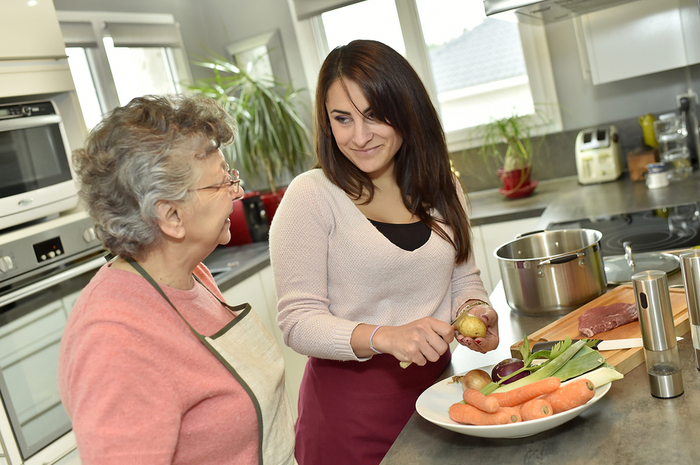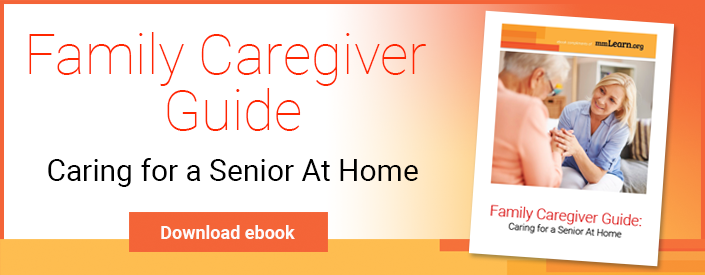
Mealtimes can be hard times of day for caregivers. Factor in Alzheimer’s disease-related issues like cognitive impairment, coordination problems, and declines in sensory perception which can lead to loss of appetite, and the challenges faced by caregivers rise.
The good news? While there’s no cure-all for these issues, caregivers can take some steps to improve breakfast, lunch and dinner for people in their care. Read on for a roundup of 10 ways Alzheimer’s caregivers can make mealtimes easier.
1. Create a conducive setting.
People with Alzheimer’s disease may have trouble focusing. Caregivers can help by creating a distraction-free zone. Turn off the television, radio, and other distractions; set a simple table; and avoid placing extraneous items, such as floral arrangements, on the table.
2. Help the food stand out from the plate.
Because Alzheimer’s disease can affect a person’s visual and spatial abilities, individuals may struggle with differentiating items on the table. Using plates with solid, contrasting color linens makes it easier to identify the food from its background. Conversely, patterned materials can have the opposite impact.
Trying to boost an Alzheimer’s patient’s food intake? Use a red plate. According to researchers at Boston University, people with Alzheimer’s disease eat 25 percent more when served meals on red plates!
3. Always test the food temperature.
People with Alzheimer's may be unable to determine when foods and beverages are too hot. To avoid burns, check food and beverage temperatures before serving.
4. Keep the number of foods served to a minimum.
While a smorgasbord of offerings may sound wonderful to you, it can be overwhelming for an Alzheimer’s patient. To avoid this, offer only one or two foods at a time.
5. Keep taste in mind.
The best way to get someone with Alzheimer's to eat? Offer something appetizing. At the same time, it’s important to remember that people with Alzheimer’s may develop new food aversions or preferences.
6. Allow plenty of time for meals.
Aside from the fact that no one enjoys being rushed through a meal, people with Alzheimer's may simply need more time to eat—as much as an hour or more for a meal. Allow adequate time, and encourage him/her to chew and swallow slowly.
7. Make meals a social occasion.
Mealtimes are inherently social. However, given the daily demands of caregivers, many use this time to attend to other duties. As much as possible, resist this temptation and use mealtimes as an opportunity to eat together and enjoy each other’s company. This will improve the experience for you both.
Additionally, staying with an Alzheimer's patient while he/she is eating offers other benefits, as well, including modeling behaviors, observing the process, and providing assistance, if necessary.
8. Find other opportunities for eating.
Getting an Alzheimer’s patient to sit for a meal isn’t always possible. Offering nutrient-dense snack opportunities throughout the day can help ensure that nutritional needs are being met.
9. Instill independence as much as possible.
Whether trying to rush things along or “make things easier,” caregivers may end up attending to tasks that Alzheimer’s patients could otherwise do for themselves. By allowing aging loved ones to do for themselves as much as safely possible, Alzheimer’s caregivers can nurture a sense of control, independence and dignity. This applies to eating, as well as to preparation and cleanup.

10. Plan to adapt.
As an Alzheimer’s caregiver, you’re likely already aware that things rarely go as planned. This absolutely applies to mealtime. Factor in that Alzheimer's patients are constantly changing, and attempting to predict what to expect during mealtimes can be an impossible task. The solution? Flexibility. If the patient is struggling with silverware, go with finger foods. Is the patient requesting breakfast after already eating breakfast? Breakfast-for-lunch, it is!
There’s no denying that mealtimes won’t always go as planned, and may often be the hardest parts of the day. However, your approach and attitude can make all the difference when it comes to facilitating the most positive and beneficial experience for someone with Alzheimer's. One rule of thumb worth keeping in mind—both during mealtimes and in general when providing care for an Alzheimer’s patient? Patience is always the best practice.
If you're looking for a comprehensive resource for family caregivers, check out our online Family Caregiver Guide.
mmLearn.org offers a large library of free videos for caregivers of older adults, covering topics pertaining to senior care on everything from sundowning to families coping with dementia. Whether you are a healthcare professional or a family caregiver, if you are caring for an older adult we know that you will find mmLearn.org an essential learning and guidance tool for all of your caregiver training needs. Access our database of free online caregiver videos for more online training resources for caregivers.

